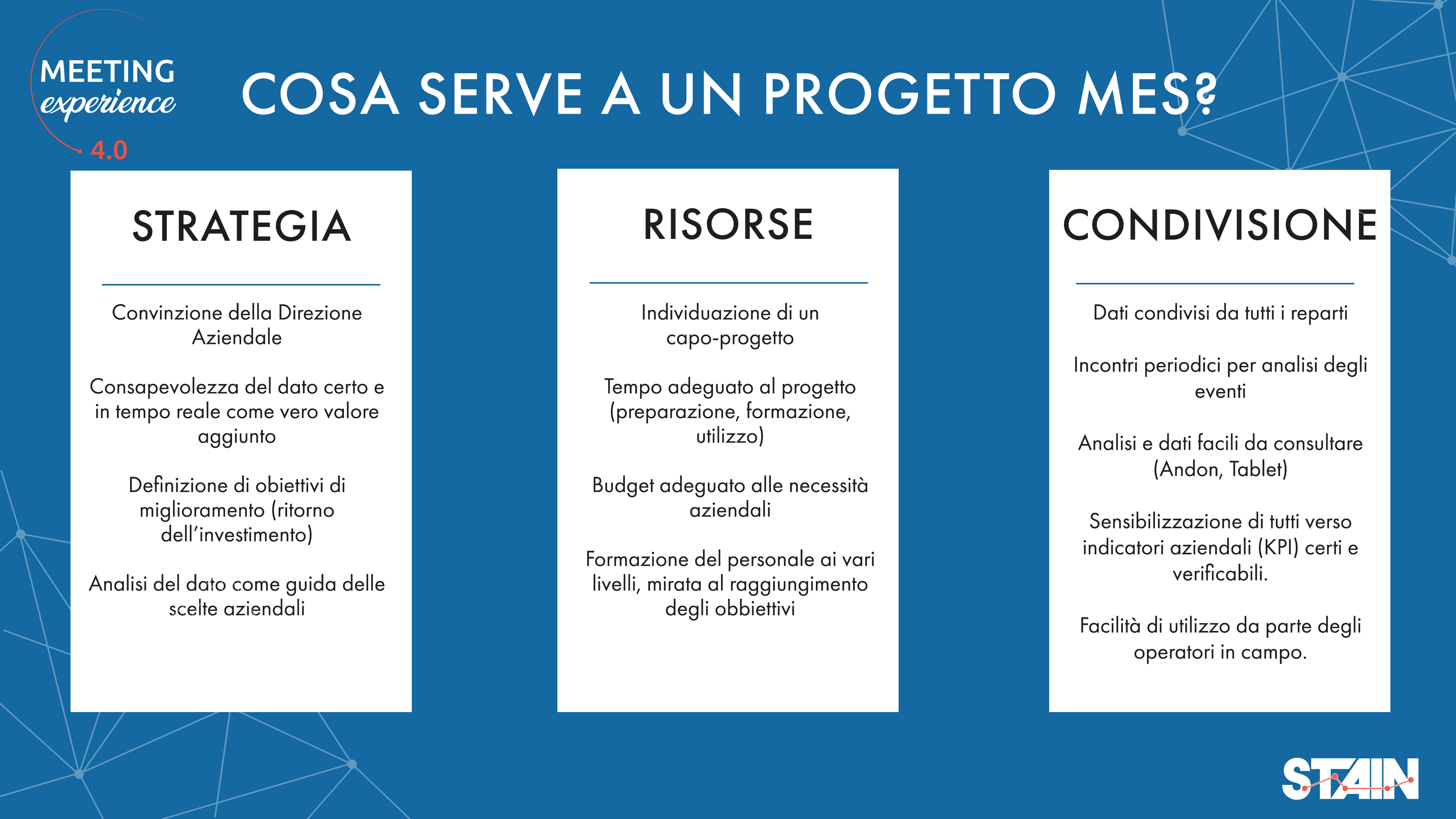A meeting to share experience and network
MES (Manufacturing Execution System) is software that makes a significant impact on an organisation and changes work methods, therefore we wanted to create an informal opportunity to share opinions, address concerns, and engage with others who already have experience of the MES solution.
During the first Meeting Experience session on Thursday 7 November, two managers from leading companies in the automotive industry, Streparava S.p.A. and Galba, talked about their experience of using the MES software, illustrating the challenges and benefits obtained so far, and answering questions from other managers and entrepreneurs who are currently considering this type of solution.
On opening the session, Andrea Casati, Commercial Manager at Stain, introduced the topics and aims of the session, emphasising how the inclusion of MES software isn't just a simple software installation, but a process that involves technological, strategic and procedural aspects.
The key points of contributions from guests are outlined below.


Andrea Ferrari – Plant Manager Streparava Spa
“Introducing MES to reduce the amount of time wasted”
At Streparava the decision to introduce a MES solution transpired from the need to optimise the use of time, first of all in relation to shift supervisors who previously had to spend hours interpreting and processing information in paper format. Shift supervisors don't have to be admin clerks, but they have a strategic role and must be organised to ensure everything runs smoothly, and contribute to improving productivity along with their teams. Along with introducing the MES solution to digitalise processes, we organised an internal team and started to gather and explain the data on various machines. The first observation was that OEE measured by the MES was 7-8% lower than the previous measurement, because with the paper measurements, times were neither certain nor accurate.
“The importance of motivating and training operator”
After initial data collection, which was constructive with operators logging stoppages immediately after events, we observed a decrease in data entry as employees resumed the old mindset, by logging downtime reasons on paper and entering the data at the end of shifts, with all the inaccuracies that this entails. Additionally, when operators felt they were being monitored they did not complete downtime reasons correctly, therefore it was necessary to continue explaining the importance of gathering data in real time. Our strategy for dealing with this is to deliver a considerable number of hours of classroom-based training for personnel, and allocate responsibility to operators, by having 2 of them in the work teams. Now at Streparava we have an annual productivity increase target of 6% (waste reduction, OEE improvement). This is our idea of ongoing improvement, and achieving this target is made possible by the MES and its correct use by everyone.
“Proceed one step at a time”
More mature operators often say: "We've always done it this way, why change?” Or shift supervisors will say: "Do I have to do this as well?" "We explain to them that this is their job, and we're giving them the tools to improve their work." The most difficult thing is motivating operators, but the trick here is one step at a time, making it as easy as possible for them to use, for example by entering just a few reasons at the beginning, and developing this over time.
Ferruccio Bosetti – IT Department Manager Galba
"The MES software only makes sense if it has a central role"
Stain MES is perfect, the most difficult part is training personnel to log downtimes. Training is essential. My advice is that if Stain MES is to be used it should be introduced to everyone. Many people install it, see how it goes for a while, and then put it in a 'corner'. This isn't the right strategy. If MES is being installed it must have a central role from the start as a reference for productivity. The advice is to get Stain and commit to it, insisting that it is used by everyone.
Claudio Manziana - Time & Method Manager at Galba
“Appoint a team leader with global vision”
It is essential to appoint a coordinator who has a general vision, and not a specialist technician who solves specific problems. A leader who motivates people is needed. At Galba we have meetings every morning to foster responsibility among operators. For half an hour every day we have stand-up meetings, when we issue and discuss the MES data.
Claudio Morbi, CEO at Stain Srl
“Technology on its own isn't enough”
MES works if operators get annoyed with machinery stoppages, meaning that the operators themselves participate in improvements. Technology is essential for improving, but it's not enough on its own, it must go hand in hand with organisation. Improvement in a company only happens when everyone is going in the same direction.
“Lots of small improvements that together make a difference”
The MES software is a tool and it can't perform miracles on its own, it's the general company vision that makes the greatest improvement. The MES software points out what people can't see, and helps to make small improvements that together make a big difference.
Conclusions
“People will always be key”
In conclusion, all contributors and guests agreed with the following statement: “People will always be key.” Implementing projects such as this requires, first and foremost, considerable determination, commitment and a can-do attitude from the project leader, in addition to people in the field. Nowadays technology and MES solutions are essential for managing production, but for ongoing improvement human resources are even more essential. It is only with contributions from people that technology can enable a company to reach high levels of innovation and organisation, improving economic results as a consequence.